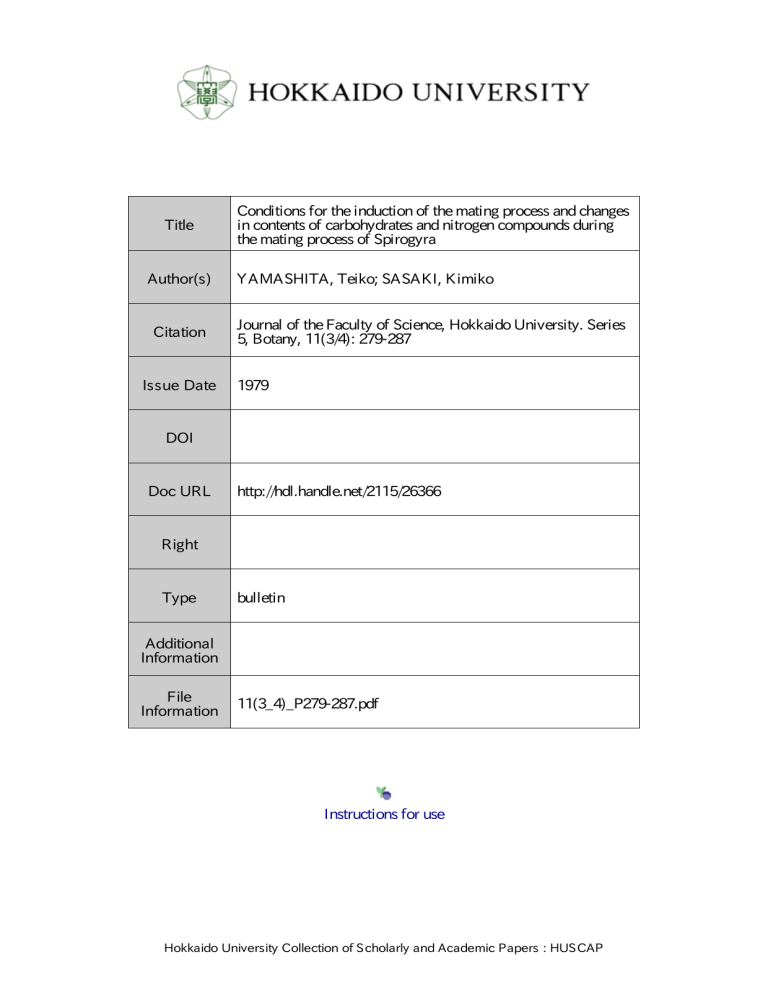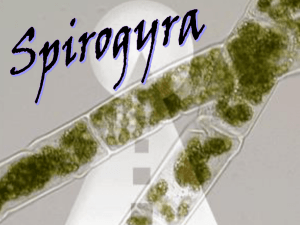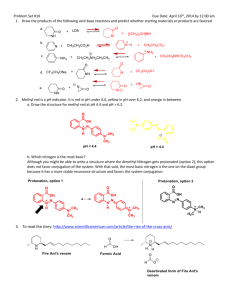Instructions for use Title Conditions for the induction of the mating
advertisement

Title
Author(s)
Citation
Issue Date
Conditions for the induction of the mating process and changes
in contents of carbohydrates and nitrogen compounds during
the mating process of Spirogyra
YAMASHITA, Teiko; SASAKI, Kimiko
Journal of the Faculty of Science, Hokkaido University. Series
5, Botany, 11(3/4): 279-287
1979
DOI
Doc URL
http://hdl.handle.net/2115/26366
Right
Type
bulletin
Additional
Information
File
Information
11(3̲4)̲P279-287.pdf
Instructions for use
Hokkaido University Collection of Scholarly and Academic Papers : HUSCAP
Journ. Fac. Sci., Hokkaido Univ. Ser. V (Botany), 11 (3, 4): 279-287, 1979.
Conditions for the induction of the mating process
and changes in contents of carbohydrates
and nitrogen compounds during the
mating process of Spirogyra
Teiko YAMASHITA and Kimiko SASAKI*
Induction of the mating process in Spirogyra sp. was done successfully by the
following procedures: the vegetatively growing cells were precultivated on a solid
medium or in a liquid medium containing glucose (0.5 to 1.0%) and an extremely
small amount of nitrate at 15°C for four weeks under continuous illumination, then
the cells were incubated in a liquid mating medium without nitrogen source at 15°C
under continuous illumination and gentle aeration.
During the mating process, intracellular carbohydrates, mainly starch, increased
markedly, while nitrogen compounds decreased. A high C/N ratio produced by
depletion of nitrogen compounds seemed to be needed for the induction of the
mating process.
It has been reported that in several algae the induction of the mating
process is depended on light and nitrogen depletion (FOSTER, 1957 and 1959;
ICHIMURA, 1971; LEVIN, 1954 and 1956; SAGER and ORANICK, 1954; UENO
and SASAKI, 1978). Some strains of Spirogyra conjugated in a definite season
of the year under natural conditions (SASAKI, 1977). In Spirogyra cells,
artificial induction of a synchronous mating process is very difficult. Although
there have been a few reports of artificial induction of the mating process
in some strains of Spirogyra (CZURDA, 1933), reliable conditions for the repetition of the induction of the synchronous mating process are not yet
known. To succeed in artificial control of the cell cycle or the life cycle
in Spirogyra or other algae, is necessary, first, for further studies of the
physiological and biochemical properties related to sexual differentiation and
the mating process in green plants.
This paper will report the conditions needed for the induction of the
sexual process and the quantitative changes in carbohydrates and nitrogen
compounds in Spirogyra cells during the mating process.
*
To whom reprint requests should be addressed.
280
Teiko Yamashita and Kimiko Sasaki
Materials and Methods
Plant materials: Spirogyra sp. (cell width, approx. 75 pm) was collected
from a pond on the campus of Hokkaido University at different stages of
the life cycle. Under natural conditions, this material conjugated almost
synchronously in June (SASAKI, 1977). The mating process was conveniently
classified into 6 stages: (1) pairing, (2) swelling, (3) budding and conjugation
tube-forming, (4) conjugation tube-connecting, (5) protoplasm-translocating
(gamete-migrating), and (6) new zygote stages.
Culture conditions: Basal culture medium consisted of KNOg (0.2 g),
MgS04,7 H 2 0 (10 mg), KH 2P04 (20 mg), FeS04,7 H 2 0 (5 mg), and distilled
water (I), and pH of the medium was adjusted to 6.6, 7.4, 7.S, or S.4 (CZURDA,
1933). The solid medium contained agar (3%) and the basal medium. The
liquid glucose medium contained the same components as the basal medium
except glucose (0.5-1.0%) and KNOg (0.0002%). The liquid mating medium
was made by elimination of nitrogen source from the basal medium. For
artificial induction of the mating process, vegetatively growing cells were
precultivated on the surface of the solid medium, or in the liquid glucose
medium under gentle aeration, at 15°C under continuous illumination for
7, 20, 30, 36, 40, or 45 days, then the cells were incubated in the liquid
mating medium at 15°C under continuous illumination and gentle aeration
until they reached the zygote stage. The light source was four 100 watt
Toshiba white lamps to get approx. SOOO lux.
Assays: Reducing sugar was determined by the Bertland method. Cells
were dried and homogenized in distilled water. The amount of free reducing
sugar in the soluble fraction separated from the insoluble fraction of the
homogenate was indicated as glucose. The total amount of carbohydrates
in the homogenate was determined after hydrolysis with 0.5 N HCI at 100°C
for 4 hr and indicated as glucose. The amount of starch in the homogenate
was indicated as a difference between the amounts of the total and soluble
free carbohydrates.
Total nitrogen content in the dried cells was determined by the Kjeldahl
method.
Free amino acids in soluble fraction of the cells were assayed by paper
chromatography. The filter paper used was Toyo-filter paper No. 50, the
solvent system was a mixture of n-butanol, acetic acid, and water (9: 1 : 7),
and the indicator was ninhydrine (0.1% in n-butanol).
Endogenous respiratory activity, Qo" and RQ were measured manometrically with 0.2 g fresh weight of the cells in 2.0 ml of 0.02 M phosphate
buffer (pH 7.2) at 25°C in the dark (SASAKI, 1977).
C/IV ratio daring conjugation loj Spirogy ra
281
Results and Discussion
Cell size of conjugating cells: S h or t cells paired and fo rmed th e conjugation tube shortly after th e fin al cell di vision (Fig. 1). A fter the pairing ,
furth er cell grow th and cell di vision wer e repressed and th e cell form sequentially changed. Cell division prior to co njugatio n may be a sor t of sexual
5
Fig. !.
Mo rphological changes of Sj;irogyra sp. dur ing natural co njugatio n
process. I - a, vegetative L-cells o r game ta ngial mother cells; I - b. swelli ng
cells; 2, pair ing and budd ing cells; 3, co njugation tube-co nnected cel ls; 4,
aggregati ng, migrati ng a nd fusing gametes; 5, fusing gametes and new zy gotes : 6. new zygotes .
282
Teiko Yamashita and Kimiko Sasaki
cell division as shown in Closterium (IcHIMURA, 1971; UENO and SASAKI,
1978) because further cell division was stopped and the cells transformed
to gametes. Before the cell division, sexual differentiation may be occured,
then gametangial mother cells which have long forms may be formed. Shortly after the cell division, short cells may have an ability to change to gametes
but may not have the ability to divide, while long cells, just before the cell
division, may not have the ability to change to gametes. At the definite
conjugation period under natural conditions, a lot of the cells almost synchronously conjugated. A few cells missed conjugation, grew into abnormally
elongated cells, and finally died, as further cell division was repressed
(SASAKI, 1977). These results suggest that after sexual cell division, vegetative
growth and further cell division were repressed, thereafter the sexual process
was induced via metabolic changes. Nitrogen deficiency was necessary conditions for the induction of the sexual process in Closterium under illumination. Therefore we assumed that in Spirogyra sexual differentiation from
vegetative cells to gametangial cells and gametes may be induced by nitrogen
deficiency in the light.
TABLE
1.
Effects of light and depletion of nitrogen source on
artificial induction of the mating process
tl~('
Culture conditions
Preculture
Medium
Duration
(days)
Liquid glucose medium
0
(0.0002% KN0 3)
Mating culture
Nitrogen
Light
source
Conjugation*
----_._----
Light
None
7
20
+
+
+
+
30
36
40
45
0-45
Solid medium
(0.02ro KN0 3)
*
Presence
7
Light
7
Dark
30
Light
30
Dark
40
40
Light
None
+
+
Dark
After 10 to 14 days of the mating culture, zygotes were formed (+) or not
formed (-). Zygotes were formed at pH 6.6, 7.4, 7.8 or S.4.
CjN ratio during conjugation of Spirogyra
283
Conditions for induction of mating process: Sexual process was artificially induced in a strain of Spirogyra (cell width, approx. 75 pm) which
conjugated in June under natural conditions. The conditions for the artificial
induction were as follows: after the preculture of vegetatively growing cells
on the surface of solid medium, or in the liquid glucose medium under gentle
aeration, at 15°C for 4 weeks under continuous illumination, the cells were
incubated in the liquid mating medium in the absence of nitrogen source
at 15°C under continuous illumination and gentle aeration. Under the conditions, the cells were conjugated after 10 to 14 days (Table 1). When the
vegetative cells were precultivated in the liquid medium without glucose in
the presence of nitrate, the cells could not conjugate. The cells precultivated
in the dark could not conjugate. Without the precultivation, the vegetative
cells could not change to gametes. The cells precultivated could not conjugate in the dark during the mating culture, or in the presence of nitrogen
source. Gentle aeration during the preculture and the mating culture was
a procedure necessary to support normal growth and conjugation. Vigorous
aeration injured the vegetatively growing and conjugating cells. In the culture
media used here, carbone dioxide was not supplied. Therefore, it was suggested that aeration may have a role in sufficient supply of CO 2 as a result
of the increase in endogenous respiratory activity. Light less 7000 lux could
not induce the conjugation. These results indicate that nitrogen deficiency
in the light is strict conditions for the induction of mating process in Spirogyra as shown in Chlamydomonas (FOESTER, 1957; LEWIN, 1954, 1956;
SAGER, 1954) and Closterium (ICHIMURA, 1971; UENO and SASAKI, 1978).
Data on effects of glucose and intensity of light on the zygote formation
suggested that light may have a role in accumulation of photosynthetic products for the formation of mature zygote, as seen in accumulation of
starch in seeds of higher plants. True role of nitrogen deficiency for the
induction of sexual process is uncertain now.
Changes in contents of carbohydrates and nitrogen compounds during
conjugation process: Contents of starch and total carbohydrates increased
during both the natural (Table 2) and artificial (Table 3) conjugation processes. Of soluble carbohydrates, arabinose and glucose decreased during
the natural conjugation process, while polymerized arabinose and glucose
increased (YAMASHITA, TAKAHASHI and SASAKI, 1968). These results supported an assumption that a role of the light for conjugation is in photosynthesis for accumulation of large amounts of starch and other polysaccharides.
The endogenous respiratory activitiy, Qo" and RQ values decreased
284
Teiko Yamashita and Kimiko Sasaki
during the natural (Table 2) and artificial (Table 3) conjugation processes.
In a previous study, it was shown that the endogenous respiratory activity
increased temporarily in a short period of early conjugation stage, thereafter
TABLE 2.
Changes in contents of carbohydrate and nitrogen
compounds during natural conjugation process
Cell stage*
Assay
Cells (mg, dry wt.)
Carbohydrates (% of dry wt.)
Soluble
Starch
Total
Nitrogen (% of dry wt.)
Total
C/N ratio (carbohydrates/
nitrogen)
V
1
2
3
4
5
6
41.5
24.4
34.3
33.3
30.2
34.5
41.8
4.1
25.8
29.9
4.9
32.9
37.8
5.3
29.2
34.5
9.3
38.9
48.2
14.8
46.2
61.0
11.3
36.8
48.1
4.8
56.2
61.0
3.9
3.1
3.5
3.4
2.3
3.0
7.7
12.2
13.8
17.9
20.9
20.3
2.37
0.86
Qo,
RQ
1.28
0.53
0.41
0.37
0.03
0.58
0.04
1.60
1.08
* Cell stages: V, vegetatively growing stage; 1, pairing stage; 2, swelling stage;
3, budding and conjugation tube-forming stages; 4, conjugation tube-connecting
stage; 5, protoplasm-translocating stage; 6, new zygote stage.
TABLE 3.
Changes in contents of carbohydrate and nitrogen
compounds during artificial mating process
Cell stage
Assay
Cells (mg, dry wt.)
Carbohydrate (70 of dry wt.)
Soluble
Starch
Total
Nitrogen (% of dry wt.)
Total
C/N ratio (carbohydrates/
nitrogen)
QQ,
RQ
*
o
Preculture (days)
14
28
(in light)
Mating culture (days)
10
14
(in dark) (in light)*
16.0
22.0
21.2
14.5
12.0
Trace
13.2
13.2
5.5
21.0
26.5
11.0
14.5
25.5
Trace
21.0
21.0
Trace
46.2
46.2
5.5
3.7
3.4
3.3
2.5
2.4
7.2
7.5
6.4
18.4
2.58
1.02
1.60
1.09
1.06
1.14
0.84
0.64
After 10 to 14 days, conjugation was detected in the light.
CjJV ratio during conj ugat ioll bf Spirogyra
285
decreased sharply (SASA KI, 1977). These results suggest that the accumulation of large amounts of starch in conjugatin g and new zygote cells can be
attrib uted to the decrease of the activity to consume carbohydrates as an
Fig. 2. Starch gra nules in s welling, co njugati ng , and zygote cells. Starch was
detected by iodo-starch r eaction. a, s li ghtly s welled ce ll s; h , co nju gation
tube-formed cells which mi ssed an opportu nit y to mate ; c, new zygote.
0
II~®
@® • I
@ I ,
@
I
v
~ leu
,III i
3
~M.t
I®
• , ®
'
4-
~ A la
~AsP
iGIY
• t
5
6
Asn
5
Fig . 3. Paper chro mat ogra ms of free amino acids in vegeta ti ve ce lls and in
naturally conjugating cells. Asn, as paragine ; Asp, aspartic acid ; Ala, alanine;
Gly, glyc ine; Leu, leuc ine; Met, methio nine. ~ ,large amounts ; ® , medium
amounts; 0 , s mall amounts. Cell stages: V, vegetative cells; 1, pairing
cells; 2, swelling cells ; 3, buclcling and conjugation tube-forming cells ; 4, conjugat ion tube-connected cel ls; 5, fusi ng gametes; 6, ne w zygo te; S, s tandard .
286
Teiko Yamashita and Kimiko Sasaki
energy source during the mating process. Conjugation-missed pamng, swelling and conjugating cells could not accumulate large amount of starch (Fig.
2). Starch decreased in aged zygotes.
Total nitrogen contents decreased while soluble amino acids, mainly
alanine, aspartate, asparagine, glycine, leucine, and methionine, increased
during the natural (Table 2, Fig. 3) and artificial (Table 3) mating processes.
These results suggested that the depletion of the nitrogen source under the
light induces partial degradation of preexisting intracellular nitrogen compounds, mainly protein, and that such degradation can induce repression of
vegetative growth. The ratios of carbohydrates to nitrogen compounds
(C/N ratio) was higher in conjugating cells and in newly formed zygotes
than in vegetative cells, as a result of the increase of carbohydrates and
the decrease of nitrogen compounds. Under intracellular conditions that
produce a high CIN ratio as shown in conjugating cells, vegetatively growing cells may can change to gametangial cells.
A more detailed clarification of the reason for induction of the sexual
process by nitrogen depletion under illumination and for changes in carbohydrates and nitrogen compounds during the sexual process will be attempted
in further studies.
References
CZURDA, V. 1933. Experimentelle Analyse der kopulations-auslosenden Bedingungen
bei Mikroorganismen. Beihefte. z. Bot. Cent. 51: 711-762.
FOESTER, H. 1957. Das Wirkungsspectrum der Kopulation von Chlamydomonus
eugametos. Z. Naturf. 12 b: 765-770.
ICHIMURA, T. 1971. Sexual cell division and conjugation-papilla formation in sexual
reproduction of Closterium. Proc. VIIth Inter. Seaweed Symp. 208-214.
LEWIN, R. A. 1954. Sex in unicellular algae. In: D. WENRICH ed., Sex in microorganisms. pp. 110-133. Amer. Assoc. Adv. Sci., Washington.
LEWIN, R. A. 1956. Control of sexual activity in Chlamydolllonus by light. J. Gen.
Microbiol. 15: 170-185.
NICOLAI, E. & PRESTON, R. D. 1952. Cell-wall studies in the Chlorophyceae. 1. A
general survey of submicroscopic structure in filamentous species. Proc.
Roy. Soc. B. 140: 244-274.
SAGER, R. & GRANICK, S. 1954. Nutritional control of sexuality in Chlamydomonus
reinhardi. J. Gen. Physiol. 37: 729-742.
SASAKI, K. 1977. Changes in respiratory and photochemical activities during the
conjugation process of Spirogyra. J. Fac. Sci., Hokkaido Univ., V, 10: 209218.
SASAKI, K. & TAKAYA, K. 1972. Suppression of nucleic acid synthesis in mitochondrial and chloroplast fractions of Spirogyra during the conjugation
process. Plant & Cell Physiol. 13: 737-740.
CjN ratio during conjugation of Spirogyra
287
SASAKI, K, TAKA Y A, K & ONODA, T. 1966. Metabolism of Spirogyra during the
conjugation process. Nature 200: 1042.
SASAKI, K, TAKA Y A, K & UENO, T. 1972. Suppression of nucleic acid synthesis
in chromatin of Spirogyra during the conjugation process. Plant & Cell
Physiol 13: 601-60S.
UENO, T. & SASAKI, K 1975. Light dependency of mating process in Closterium
acerosum. Plant & Cell Physiol. 19: 245-252.
UENO, T. & SASAKI, K 1975. Synchronous sexual cell division in L 2oo -cells of
Closterium acerosum. ]. Fac. Sci., Hokkaido Univ., V, 11: 21S-224.
YAMASHITA, T., TAKAHASHI, S. & SASAKI, K 1965. Biochemical, histochemical,
and structural changes during conjugation process of Spirogyra. Bot. Mag.,
Tokyo., 81 : 210-21S.








